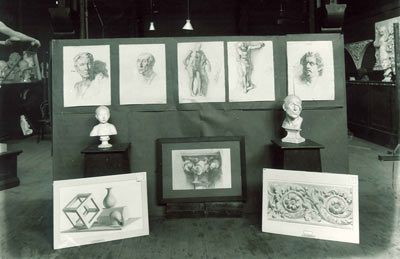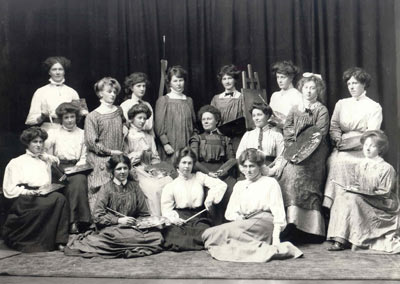| |
| Students of 1910–1920 |
| Annie Gibb |
1908–15 |
| Rose Zeller |
1909–13 |
| Grace Butler (née Cumming) |
1910–13 |
| Heathcote Helmore |
1913–15 |
| Ngaio Marsh |
1913–19 |
| Colin Lovell-Smith |
1914 |
| Evelyn Page |
1915–22 |
|
| 1910 |
The school gains a silver medal and a Queen's prize in the [British] National Competition amongst Schools of Art in the United Kingdom, held at South Kensington, London. These are the 'highest awards yet won in the Dominion.'
Alfred Walsh retires from the Canterbury College School of Art. Richard Wallwork is appointed to staff as Life Instructor (1911–27, Director 1928–46). Wallwork trained as a printmaker under Frank Short in London and played a significant role in encouraging printmaking at the School.
Richard Wallwork's class in Drawing and Painting from Life is described in the Prospectus: 'The course of these Classes includes Drawing and Painting from the living model in oil, tempera, water colour and pastel. The model will be posed from time to time from sketches made by studies for Composition Class. Students will be encouraged to make studies for carrying out their compositions. Memory drawing of the human figure will form part of the course, and on certain days students will be expected to draw from memory.'
The Prospectus indicates that the 'chief objects' of the school are:
- To provide instruction in drawing, design, modelling and painting, especially in their applications to trades and industries.
- To provide a course of study for those who desire to become painters of landscape or the figure, or to become sculptors.
- To train persons who wish to become Teachers of Art.
- To instruct those who desire to make a knowledge of art part of their general education.
|
| 1911 |
The school gains a silver medal and a Queen's prize in the [British] National Competition amongst Schools of Art in the United Kingdom, held at South Kensington, London. These are the 'highest awards yet won in the Dominion.'
Alfred Walsh retires from the Canterbury College School of Art. Richard Wallwork is appointed to staff as Life Instructor (1911–27, Director 1928–46). Wallwork trained as a printmaker under Frank Short in London and played a significant role in encouraging printmaking at the School.
Richard Wallwork's class in Drawing and Painting from Life is described in the Prospectus: 'The course of these Classes includes Drawing and Painting from the living model in oil, tempera, water colour and pastel. The model will be posed from time to time from sketches made by studies for Composition Class. Students will be encouraged to make studies for carrying out their compositions. Memory drawing of the human figure will form part of the course, and on certain days students will be expected to draw from memory.'
The Prospectus indicates that the 'chief objects' of the school are:
- To provide instruction in drawing, design, modelling and painting, especially in their applications to trades and industries.
- To provide a course of study for those who desire to become painters of landscape or the figure, or to become sculptors.
- To train persons who wish to become Teachers of Art.
- To instruct those who desire to make a knowledge of art part of their general education.
|
| 1912 |
Students decorate a small room at the Canterbury Society of Arts as a boardroom suitable for a Chamber of Commerce. Different classes design and make the mural, the decorations, the stained glass windows, the carpet and the metal fittings. |
| 1913 |
The New Zealand Education Department dispenses with the South Kensington examination system. 'From 1913, when the NZ Education Department decided to dispense with the South Kensington examination system, and 1915, when the British annual competitions were discontinued, until 1929 when the CCSA introduced a diploma, Christchurch students had no means of assessing their abilities outside annual school exhibitions and art society exhibitions.' (Ann Calhoun, Simplicity and Splendour, p.37.)
Courses in etching begin under Richard Wallwork. |
| 1914 |
World War I (1914–1918) causes a decline in the School's roll, and women students predominate. Rose Zellar edits the school magazine, The Ventilator, which was launched the previous year and is published every term.
The school's first floor is substantially remodelled, resulting in the antique studio being enlarged.
A CCSA student from 1913–19, Dame Ngaio Marsh (1895–1982) in her autobiography Black Beech and Honeydew (1966, Collins, London, Auckland) provides a picture of the War years:
'Canterbury University College School of Art was conducted on an established pattern. An antique room smelling of mice and Michelet paper, a still-life room smelling of stale vegetables, a modelling room smelling of clay, an architectural room and, exclusively at the top of its own flight of stairs, the life-room, smelling very strong indeed of paint, turpentine and hot stoves … Here we drew and painted from the head, the draped figure and the nude. The classes were mixed, the male students, because of the war, being over forty or under eighteen or not up to army medical standards. There were no entirely fit young men in New Zealand.' |
| 1915 |
The Painters' Union of Canterbury and Master Painters Association transfer painters' classes from the Christchurch Technical College to the School of Art. The architectural drawing and design room is converted into the painters' and decorators' studio. |
| 1917 |
Robert Herdman-Smith resigns. Frederick Gurnsey is appointed acting Director (1917–20). |
| 1918 |
Books acquired this year for the school library include:
- Lays's Construction Work
- Shanke's How to draw from models
- Mc Laughlin China Painting
- Warner Tree Studies
- Pencil sketching
- Art in Australia, no.4
- The Studio, vol. 72
- Pictures of war work in America by Joseph Pennell
- Printers Pic
- Studio Year Book
- Magic Pudding
- The Studio vol. 73, Royal Academy.
(from a hand-written list in the archives of the Christchurch Art Gallery) |
| 1919 |
Acting Director Frederick Gurnsey comments: 'there is a growing demand for students in industry and much to our regret, sometimes our most promising students are taken away to earn money... one of the greatest dangers an art school has to contend with.' |
|

| End of year exhibition, Canterbury College School of Arts, 1912. |
Exhibits are on display under the Directorship of R. Herdman-Smith, A.M., F.S.A.M. |

| Women Students 1910 |
Canterbury College School of Art, 1910, Grace Butler middle back row. Rose Zellar, Alice Polson, Daisy Osborn, and Margery Mains are also present. |

| Metal Workshop, Canterbury University College School of Art, c.1914–15 |
Students: Kathleen Gregory and M. Harris. 'Metalcraft' was an integral part of the school's craft and sculpture department in its early years, and thrived under the instruction of Charles Kidson, Robert Herdman-Smith and Frederick Gurnsey. |
|



